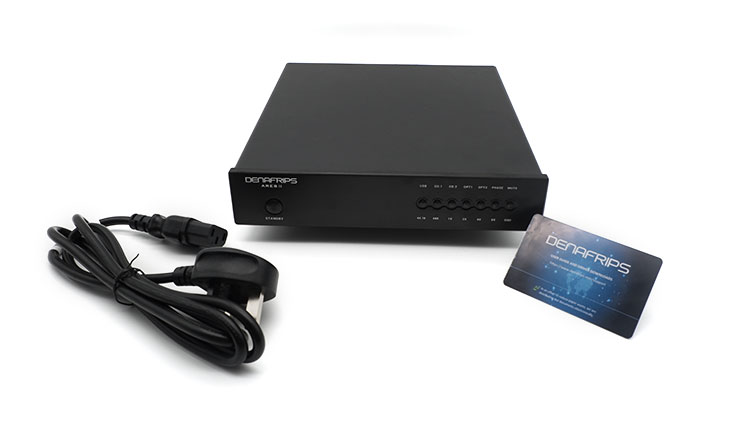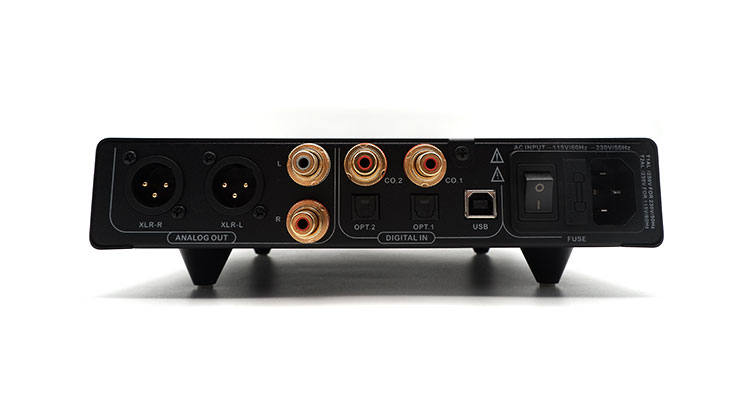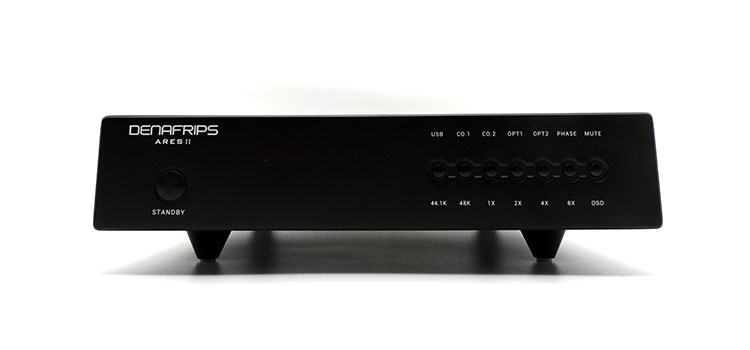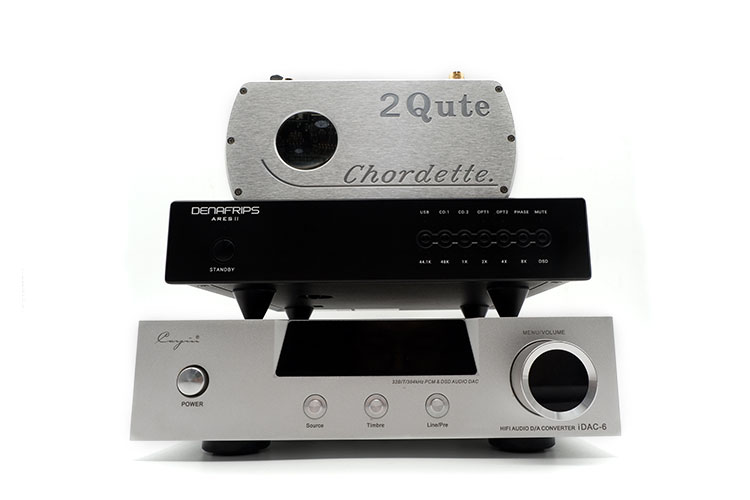This review covers the Denafrips Ares II which is a 24Bit/1536KHz, native DSD1024, desktop discrete R2R DAC. It is priced at $772.43
Disclaimer: The Denafrips Ares II was sent to us as a sample in exchange for our honest opinion. We thank Denefrips for this opportunity.
To learn more about R2R DAC products featured on Headfonics you can click here.
Note, this article follows our latest scoring guidelines which you can read up on here.
Denafrips has its roots in Guangzhou, China, where it started as a designer and manufacturer of hi-end audio equipment. They believe that high-end equipment doesn’t necessarily have to be associated with a high price tag. So in 2012, they started with 4 DACs.
Today, their current product line is composed of 5 R2R DACs, 3 DDCs, 2 Pre-amplifiers, 3 power amplifiers, and a headphone amplifier. Their DACs have recently been making waves in the high-end audio community, particularly in the 2-channel scene.
Denafrips has agreed to send us their entry-level R2R DAC, the Ares II, and it will be interesting how their success translates to the headphone space.

R2R DACs
Originally, most DACs were R2R DACs, and those were found in most devices such as CD players. These DACs are made of an array of resistors that will have a voltage pass through them based on which bit in the PCM stream is turned on at the time. The resistors that are used in these converters need to be highly precise to ensure a linear output signal.
Later on, a cheaper alternative DAC was developed, which is the Delta-Sigma DAC. Even when chip-based R2R DACs were being released, they were still generally more expensive than the Delta-Sigma alternative.
Delta-Sigma DACs are cheaper to develop and implement because they came as chips from manufacturers. Today, most DACs utilize chips from manufacturers such as ESS, AKM, Cirrus Logic, and TI.
While these Delta-Sigma DACs are more economical, the conversion inside the chips generally ends up doing some upsampling and data manipulation. This results in some aliasing of the higher frequencies into the audible range, resulting in what we sometimes perceive as digital glare. The output of Delta Sigma DACs typically needs accurate output filters to remove the effects of aliasing.
It’s clear that both methods of converting a signal from digital to analog have their advantages and disadvantages. But with recent improvements in manufacturing technology, and the demand for more natural-sounding DACs, R2R DACs have seen a rebirth in our current market.

Tech Highlights
USB Audio Interface
The STM32F446 is an arm-based high-performance microcontroller, and it has been programmed to control the USB signal, as well as the other input and output functions of the Ares II. It also serves as the DSP module onboard the Ares II.
The STM32F446 on the Ares II has been programmed to take in DSD 1064 and PCM up to 24bits/1536kHz streams. The compatibility with these formats ensures that the Ares II is future-proof as far as music formats go.
DAC
The R2R DAC inside the Ares II utilizes 4 resistor arrays to decode each channel. It means that there are 2 resistor arrays each that decode the (+) and (-) leg of the balanced signal.
The 2 resistor arrays in each part of the signal are there to prevent any linearity errors which is a common issue among R2R DACs. Essentially, each Ares II has 8 resistor arrays that are meticulously matched by a machine and double-checked manually for accuracy.
Each of the resistor arrays is made of matched resistors with an accuracy of up to 0.01%, which makes the process of matching resistors all the more difficult. These factors typically drive up the cost of any DAC that utilizes R2R technologies, but it also gives R2R its distinct sound.
Linear Power Supply
Typically, most DACs come with switch-mode power supplies(SMPS), since this approach is typically more economical. SMPS are typically more economical because they utilize a high-speed switching PWM IC that is used to directly convert AC line voltages directly to DC voltages typically used by electronics.
However, the high-speed switching of the transistor at the output of SMPS will induce harmonic voltages into the audio system.
Again, Denafrips went with a more traditional, but more expensive approach in the Ares II with the use of a linear power supply. This is done by stepping down the voltage and then converting it to the DC voltage required by electronics.
This approach will ensure that the power supply, as well as outside electrical noise, will not go into the audio system and ensure cleaner and more instantaneous availability of power. The Ares II power supply includes a voltage switch underneath the chassis, so international buyers shouldn’t be worried about compatibility with your country’s system voltage.
Design
When I lifted the Ares II out of the box, I immediately noticed the weight of the DAC. This DAC is dense, and the small box weighs 3.0kg. This weight implies that the Ares II has a lot of parts inside, including a high-quality toroidal transformer that feeds the DAC with clean and immediate power.
The DAC only comes in black, and it looks like a very traditional looking hi-fi component. The DAC is elevated by 4 spike feet that are integrated on the chassis. This ensures that the DAC is elevated from any surface, and would be isolated from mechanical noise that the surface may potentially induce into the DAC.
The front of the DAC has a standby button on the far left. On the right side of the front fascia are 7 buttons that correspond to input selection and a menu interface that’s available with the Ares II. The rear of the DAC has the input and output options, a power switch, and an IEC standard power cable.
I/O
The Ares II provides 1 USB input, 2 optical inputs, and 2 coaxial inputs, a selection that ensures that the Ares II is compatible with multiple sources. The USB input option allows for full-scale resolutions with PCM topping out at 24bit/1536kHz, and DSD 1024. The other input options are limited to PCM at 24bit/196kHz and DSD64.
The output on the Ares II is a choice between a balanced 3-pin XLR connection, and a pair of RCA connections. Both outputs are simultaneously active, so driving a balanced amp, and a single-ended amp is an option.
Interface
The interface on the Ares II is pretty simple. It’s composed of 8 buttons and 15 red LEDs in front. On the left-most portion of the front fascia is the standby button.
By default, the Ares II is on standby mode when the device is first powered on, and the standby button needs to be pressed once before the Ares II can be detected by a computer or an upstream device. Pressing the button again will put the Ares II in standby mode once more.
The 7 buttons in front are mainly for input selection, where pressing any of the first 5 buttons will switch over the DAC’s inputs to either USB, COAX 1, COAX 2, OPT1, or OPT2. The 6th button is for switching the phase of the output, which toggles between in-phase and 180° out of phase.
The final button is the mute button which mutes the device outputs. However, once the mute button is pressed, it enters the Ares II into its different menu options. While the mute button is activated, pressing the button that corresponds to OPT1 once will go into the NOS(non-oversampling)/ OS(oversampling) mode status.
Pressing the OPT1 button again will toggle between NOS/OS mode, where the status of the NOS/OS mode is indicated by the OPT1 LED. Where on corresponds to NOS mode, and off corresponds to OS mode.
While the Ares II is in OS mode, the mute button menu can also toggle between a slow filter/sharp filter by pressing the OPT2. Pressing OPT2 once will go into the status, and pressing OPT2 again will toggle between the 2 filter modes. Where the OPT2 light on corresponds to slow filter, while off corresponds to sharp filter.
Packaging & Accessories
The Ares II comes in a plain brown box, with a flap that opens from the side. Once the box is opened, there is a foam sheet 1” thick. Once the foam sheet is removed, the Ares II and a power cord are snugly placed in foam inserts that ensure that the DAC will not move during transit. The package that comes with the Ares II is on the simpler side, but it’s also cost-efficient and effective.
Sound Impressions
Introduction
When I first plugged in the Ares II, my first impression of it is that it’s not particularly impressive. I was almost ready to dismiss all the rave reviews that I’ve been hearing about it as hype.
However, 2 factors changed my mind, first is that the manufacturer recommended that I should leave the Ares II on for 10 straight days. I left it on for 10 straight days mostly without listening to it, to prevent my brain from adapting to the DAC.
After 10 straight days of leaving it on, I had the opportunity to listen to the DAC for quite a bit more time before I realized what this DAC is really about.
With my listening tests, I ended up mostly using the DAC in the OS mode, so my sound impressions will mostly apply to OS mode. An explanation of the difference between the 2 modes is in the section below.
Timbre
As I’ve already implied previously, the Ares II is not a DAC that will wow you on your first listen. The first thing that I noticed about the Ares II is that it’s very neutral. From the sub-bass all the way to the air frequencies, the Ares II presents details well and with equal emphasis in every frequency range. This ensures that each part of the music is presented with equal emphasis.
Sub-bass reaches down deep, and there is an environmental feel to the sub-bass frequencies. The mid-bass region on the other hand has a very textured quality, whereas drum beats have a hollowed texture while still retaining a natural sense of attack and decay. Furthermore, bass grooves in the bass frequencies sound distinct but reasonably flowy.
The vocal range is not particularly colored as well. When presenting powerful vocals such as the ones from Josh Groban, the vocal quality is textured and honest. Female vocals like Celine Dion also have a full quality but are not overly emphasized.
Acoustic instruments such as guitars sound very natural but precise, where each pluck has a very singular but harmonically natural character. Cellos on the other hand have a very gentle, and full-bodied character while having a graceful and flowy presentation.
Treble frequencies are controlled quite well and will be very present when called for. The treble is not particularly emphasized though, so even songs that tend to sound slightly brighter tend to be slightly tamed while remaining detailed.
Staging
Generally, the Ares II plays with a gentler wispy character, and this initially gave me an impression that the Ares II doesn’t have as much grunt.
However, when I started listening to orchestral recordings that have a wide dynamic range, such as Vivaldi’s Four Seasons, the Ares II presented both the intricate details in gentler passages, as well as the vastness of the scale of the crescendo in the song.
The soundstage on the Ares II is expansive, and there doesn’t seem to be an end to the soundstage. When listening to vast orchestral recordings, the room doesn’t seem to have a wall that terminates the soundstage.
The placement of the images within the soundstage is organic, and each element is placed appropriately far out into the stage. Each of the images created by the Ares II is chiseled and separated well from each other, which makes each instrument distinct and natural.
Layering within the soundstage is presented quite well, where sound elements don’t crowd within a small amount of space. Directionality is also very accurate, where the images created have an accurate location.
NOS vs OS
When listening to the 2 modes, the OS mode tends to have a more gentle and wispy character. NOS mode in contrast gives the Ares II a bit more body in the presentation, giving vocals a bit more girth.
While the Ares II can use a touch more girth, the girth that the NOS mode provides tends to make the Ares II sound a touch more intimate, and the images within the soundstage become a bit less defined and layered.
While I ended up preferring the Ares II with the OS mode, the NOS mode is also a good option for slightly tweaking the DAC, giving it a slightly different flavor.
Click on page 2 below for Synergy and select comparisons







